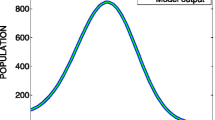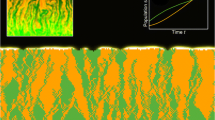Abstract
A key factor contributing to the variability in the microbial kinetic parameters reported from batch assays is parameter identifiability, i.e., the ability of the mathematical routine used for parameter estimation to provide unique estimates of the individual parameter values. This work encompassed a three-part evaluation of the parameter identifiability of intrinsic kinetic parameters describing the Andrews growth model that are obtained from batch assays. First, a parameter identifiability analysis was conducted by visually inspecting the sensitivity equations for the Andrews growth model. Second, the practical retrievability of the parameters in the presence of experimental error was evaluated for the parameter estimation routine used. Third, the results of these analyses were tested using an example data set from the literature for a self-inhibitory substrate. The general trends from these analyses were consistent and indicated that it is very difficult, if not impossible, to simultaneously obtain a unique set of estimates of intrinsic kinetic parameters for the Andrews growth model using data from a single batch experiment.



Similar content being viewed by others
References
Andrews JF (1968) A mathematical model for the continuous culture of microorganisms utilizing inhibitory substrates. Biotechnol Bioeng 10:707–723
Berthouex PM, Brown LC (1994) Statistics for environmental engineers. Lewis, Boca Raton, Fla.
Brown SC, Grady CPL Jr, Tabak HH (1990) Biodegradation kinetics of substituted phenolics: demonstration of a protocol based on electrolytic respirometry. Water Res 24:853–861
Cooper SF (1989) Determination of the biodegradation kinetics of substituted phenolics from oxygen uptake data. MSc thesis, Clemson University, Clemson
D'Adamo PD, Rozich AF, Gaudy AF Jr (1984) Analysis of growth data with inhibitory carbon sources. Biotechnol Bioeng 26:397–402
Dang JS, Harvey DM, Jobbagy A, Grady CPL Jr (1989) Evaluation of biodegradation kinetics with respirometric data. Res J Water Pollut Control Fed 61:1711–1721
Edwards VH (1970) The influence of high substrate concentrations on microbial kinetics. Biotechnol Bioeng 12:679–712
Ellis TG, Barbeau DS, Smets BF, Grady CPL Jr (1996) Respirometric technique for determination of extant kinetic parameters describing biodegradation. Water Environ Res 68:917–926
Grady CPL Jr, Smets BF, Barbeau DS (1996) Variability in kinetic parameter estimates: a review of possible causes and a proposed terminology. Water Res 30:742–748
Hill GA, Robinson CW (1975) Substrate inhibition kinetics: phenol degradation by Pseudomonas putida. Biotechnol Bioeng 17:1599–1615
Kuester JL, Mize JH (1973) Optimization techniques with Fortran. McGraw-Hill, New York
Luong JHT (1987) Generalization of Monod kinetics for analysis of growth data with substrate inhibition. Biotechnol Bioeng 29:242–248
Magbanua BS Jr, Lu YT, Grady CPL Jr (1998) A technique for obtaining representative biokinetic parameter values from replicate sets of parameter estimates. Water Res 32:849–855
Monod J (1949) The growth of bacterial cultures. Annu Rev Microbiol 3:371–394
Monteiro ÁAMG, Boaventura RAR, Rodrigues AE (2000) Phenol biodegradation by Pseudomonas putida DSM 548 in a batch reactor. Biochem Eng J 6:45–49
Pawlowsky U, Howell JA (1973) Mixed culture biooxidation of phenol. I. Determination of kinetic parameters. Biotechnol Bioeng 15:889–896
Robinson JA (1985) Determining microbial kinetic parameters using nonlinear regression analysis: advantages and limitations in microbial ecology. In: Marshall KC (ed) Advances in microbial ecology, vol 8. Plenum, New York, pp 61–114
Robinson JA (1998) Modeling microbial processes: an overview of statistical considerations. In: Koch AL, Robinson JA, Milliken GA (eds) Mathematical modeling in microbial ecology. Chapman & Hall, New York, pp 14–31
Robinson JA, Tiedje JM (1983) Nonlinear estimation of Monod growth kinetic parameters from a single substrate depletion curve. Appl Environ Microbiol 45:1453–1458
Rozich AF, Gaudy AF Jr (1985) Response of phenol-acclimated activated sludge process to quantitative shock loading. J Water Pollut Control Fed 57:795–804
Schröder M, Müller C, Posten C, Deckwer W-D, Hecht V (1997) Inhibition kinetics of phenol degradation from unstable steady-state data. Biotechnol Bioeng 54:567–576
Yang RD, Humphrey AE (1975) Dynamic and steady state studies of phenol biodegradation in pure and mixed cultures. Biotechnol Bioeng 17:1211–1235
Author information
Authors and Affiliations
Corresponding author
Rights and permissions
About this article
Cite this article
Seagren, E.A., Kim, H. & Smets, B.F. Identifiability and retrievability of unique parameters describing intrinsic Andrews kinetics. Appl Microbiol Biotechnol 61, 314–322 (2003). https://doi.org/10.1007/s00253-002-1220-4
Received:
Revised:
Accepted:
Published:
Issue Date:
DOI: https://doi.org/10.1007/s00253-002-1220-4




